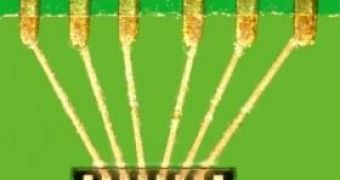Modern cars make use of a great deal of electrical and electronic devices to ensure a correct and efficient functioning. Almost every function is monitored and regulated through electronic sensors, such as fuel consumption or the amount of air being sent into to the engine's carburettor. Similar thermoelectric sensors are also used in medicine to regulate the flow of tiny amounts of drugs, thus they must be very precise as well.
A thermoelectric flow sensor usually consists of a silicon chip and a membrane placed on a circuit board, while the necessary electrical connections are ensured by thin wire connectors bonded between the silicon wafer and the printed circuit board.
"Up to now, contacting was usually done with wire bonds - thin wires, that is. But wire bonds stick out, and thus impair the flow behavior of the gases and liquids. Than can affect high-precision measurements," says Christian Werner, project manager for the Fraunhofer Institute for Manufacturing Engineering and Applied Materials Research IFAM.
The new INKtelligent printing technique developed by the IFAM project, replaces the thin wire connectors with even thinner printed conductor paths, thus minimizing the interference between the fluid flow and the thin conductor wires. "The suspension contains nano silver particles in a special solvent. This enables us to print extremely thin-layered conductor paths," Werner said.
Thin wire bonds generally reach a height of 1 to 1.5 millimeters; however, the printed conductor paths are about five hundred times thinner than wire bonds, or 2 to 3 micrometers in height. This enables the thermoelectric sensor to make very accurate measurements. The technique has already been tested by the IFAM researchers along with colleagues from the Institute for Microsensors, Actuators and Systems IMSAS in Bremen, and is behaving exactly as predicted, meaning that the engineers have been successful in solving at least one of the main problems plaguing the correct functioning of thermoelectric sensors.

 14 DAY TRIAL //
14 DAY TRIAL //